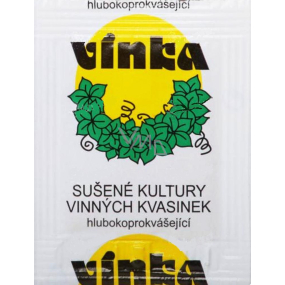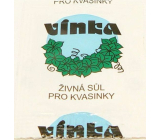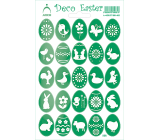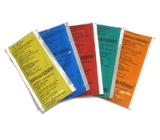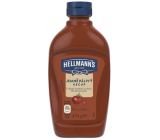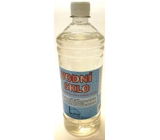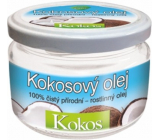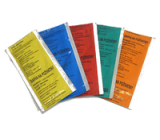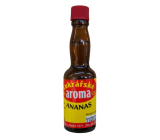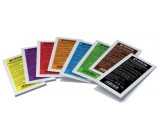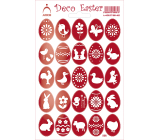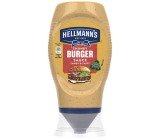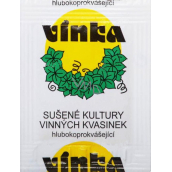Wines of dried deep-fermenting wine yeast 0.6 g
sušené kultury vinných kvasinek, zlepší kvasný proces
| Code: | 36216 |
| EAN: | 8594003170591 |
| Producer: | Frutana s.r.o. |
| Brand: | Vínka (web) |
 | |
The content of a l bag of yeast is sufficient to ferment 10 litres.
Thedry yeast is multiplied as follows before the actual fermentation of the wine:
The contents of the packet are poured into a clean (evaporated) 150 ml bottle, which is filled 3/4 full with boiled fruit juice about 25°C warm (Apple cider can also be used). The bottle is sealed with Cotton wool and left to stand for 72 hours at a temperature of around 25°C. The yeast thus multiplied ferments the fruit juice.
Procedure for the preparation of wine
A well-cleaned, hot-Water-rinsed fermentation vessel of 10 litres is filled to 9/10 with fruit juice, adjusted sugar and Water according to the table. It is not recommended to fill the bottle more than this so that the coffee does not spill out during the turbulent fermentation. The multiplied yeast, prepared according to the instructions, and 1 sachet of Vínka nutrient salt are washed into the juice and stored in a room with a temperature of about 20 to 25°C.
When making wine from fruit that is not pressed (whole fruit), e.g. rose hips, sloes, also from the cakes and bread crusts it is recommended to use double the amount of yeast, i.e. 2 sachets per 10 litres of wine.
When making wine from dried fruit, it is recommended to boil the fruit with Water and sugar
After a vigorous fermentation, the fermentation vessel is filled with boiled, cooled Water and the wine is left to ferment.
After fermentation is complete, usually in 3 to 6 weeks, the wine is decanted from the settled lees with a Rubber boiled tube into a clean, preferably boiled, container so that the fermentation sediment does not boil off. The container filled with wine up to the neck is sealed either with fermentation again or with a clean cork stopper and left to stand for about 2 months. After this time, a second bottling of the wine from the lees is carried out directly into bottles. The use of yeasts without the addition of nutrient salt is not excluded for common fruits.
the juice of some fruits is not very acidic (e.g. from pears, cherries, etc.), and therefore the wine would have a bland taste." Such wine can be acidified with Citric Acid. This recipe corresponds to fruit of medium sweetness. If the fruit is less sweet, the amount of sugar must be increased proportionately. The prescribed amount of juice can be reduced, but each litre should be replaced with a litre of Water and 25 dkg of sugar. Wines prepared according to this recipe are dry to slightly sweet. If we want to prepare dessert wines (sweet), we increase the proportion of sugar by 0.5 kg per 10 litres of wine and sweeten the finished wine with 5 to 10 dkg of sugar for each litre of wine according to taste.
This item has not been discussed yet. If you want to be first, click on the button Add a contribution
The content of a l bag of yeast is sufficient to ferment 10 litres.
Thedry yeast is multiplied as follows before the actual fermentation of the wine:
The contents of the packet are poured into a clean (evaporated) 150 ml bottle, which is filled 3/4 full with boiled fruit juice about 25°C warm (Apple cider can also be used). The bottle is sealed with Cotton wool and left to stand for 72 hours at a temperature of around 25°C. The yeast thus multiplied ferments the fruit juice.
Procedure for the preparation of wine
A well-cleaned, hot-Water-rinsed fermentation vessel of 10 litres is filled to 9/10 with fruit juice, adjusted sugar and Water according to the table. It is not recommended to fill the bottle more than this so that the coffee does not spill out during the turbulent fermentation. The multiplied yeast, prepared according to the instructions, and 1 sachet of Vínka nutrient salt are washed into the juice and stored in a room with a temperature of about 20 to 25°C.
When making wine from fruit that is not pressed (whole fruit), e.g. rose hips, sloes, also from the cakes and bread crusts it is recommended to use double the amount of yeast, i.e. 2 sachets per 10 litres of wine.
When making wine from dried fruit, it is recommended to boil the fruit with Water and sugar
After a vigorous fermentation, the fermentation vessel is filled with boiled, cooled Water and the wine is left to ferment.
After fermentation is complete, usually in 3 to 6 weeks, the wine is decanted from the settled lees with a Rubber boiled tube into a clean, preferably boiled, container so that the fermentation sediment does not boil off. The container filled with wine up to the neck is sealed either with fermentation again or with a clean cork stopper and left to stand for about 2 months. After this time, a second bottling of the wine from the lees is carried out directly into bottles. The use of yeasts without the addition of nutrient salt is not excluded for common fruits.
the juice of some fruits is not very acidic (e.g. from pears, cherries, etc.), and therefore the wine would have a bland taste." Such wine can be acidified with Citric Acid. This recipe corresponds to fruit of medium sweetness. If the fruit is less sweet, the amount of sugar must be increased proportionately. The prescribed amount of juice can be reduced, but each litre should be replaced with a litre of Water and 25 dkg of sugar. Wines prepared according to this recipe are dry to slightly sweet. If we want to prepare dessert wines (sweet), we increase the proportion of sugar by 0.5 kg per 10 litres of wine and sweeten the finished wine with 5 to 10 dkg of sugar for each litre of wine according to taste.
